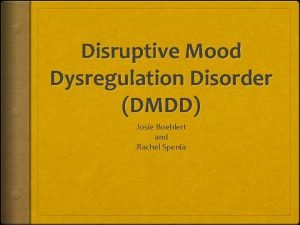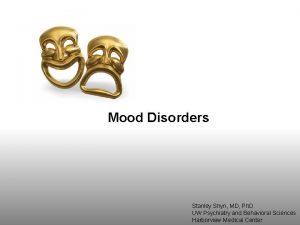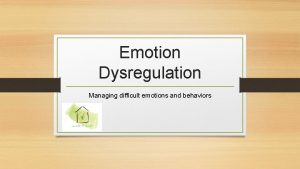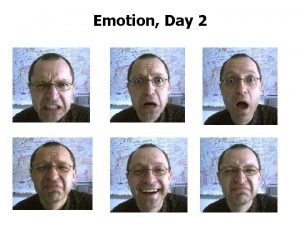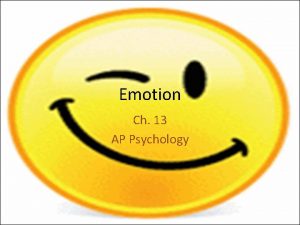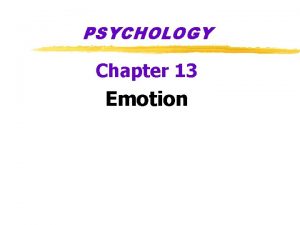The Challenging Child Summers ChazanCohenChapter 2 Emotion Dysregulation








- Slides: 8

The Challenging Child Summers & Chazan-Cohen-Chapter 2

Emotion Dysregulation • Emotion regulation-to survive & thrive; all living things need an organized, coherent response to stressful events & experiences (it is that organized, coherent response that is emotion regulation) • • Emotion dysregulation-the lack of an organized response to a stressful or upsetting event • • One of the most destructive observable behaviors in the context of dysregulation is aggression • a very common part of a young child’s dysregulated response to frustration & anger Developmental experts don’t expect toddlers & preschoolers to be fully in control of their reactions • important to know what is expected based on age and developmental expectations Emotion regulation is an important skill related to other functions • • • paying attention, focusing making & keeping friends solving social problems tolerating frustration doing well academically

The Development of Emotion Regulation • Good predictors of a child’s emerging emotional capacities are reflected in parenting behavior • studies show that when parents & their infants have a warm, positive relationship, and when parents model good emotion regulation, infants are likely to show progress toward developing those same skills • Physical contact and soothing are the primary means for caregivers to model and provide emotion regulation to their infant • • rocking, holding, stroking, & speaking softly adult has calm physical presence • Parental depression, illness, personal stress, physical or emotional discomfort, exposure to trauma, & difficult feelings about the infant can affect the way the caregiver can tolerate & accept the distress of the infant • Infants are not in control of their emotions and behavior; caregivers must be able to help them

How Does Temperament Play a Role? • Temperament-biologically, constitutionally based individual differences in characteristic behavioral and response style • • • remains generally consistent across settings, experiences, and time 9 dimensions of behavior responding easy, slow-to-warm, & difficult children • One of the most important concepts in temperament research is “goodness of fit” • • Is there a good fit between the infant’s temperament & the caregiver? the match between a child’s temperament & the personality and parenting behavior of the caregiver is called “goodness of fit” • Activity • • • CSEFEL Module 1 Handout 1. 12 Temperament Continuum CSEFEL Module 1 Handout 1. 14 Temperament Traits Booklet (Activity) IT 3 Infant & Toddler-quiz

Emerging Emotion Regulation in Toddlers • As children mature and learn new skills, they are better able to regulate their emotions through prosocial regulation strategies such as language, comfort seeking, and cooling strategies (Sethi et al. , 2000) • Cooling strategies • when something frustrating occurs & cannot be solved alone, the child either needs to wait for someone to help solve the problem or needs to move to a different experience altogether • emotional & behavior regulation are required in the form of shifting attention away from the “hot” to “cool” the child • • a complex task that requires a cognitive, attention, & physical shift by the child being able to demonstrate that shift of attention is a hallmark of emotion regulation

The Importance of Language & Culture • Toddlers emerging use of language is one of the clearest ways they can begin to ask for and receive help when they are distressed • Toddlers whose language skills are slow to emerge typically experience more challenges with emotion regulation development • The development of emotion capacities in some children may vary based on culture • related to physical contact, along with neutral and nonnegative emotional displays from the parent • • some cultures use a lot of physical contact, others do not • acceptance of negativity is very likely to vary across various cultural groups some use more face-to-face interactions, affectionate touching, and indirect forms of assistance in completing tasks (toddlers)

• • • Emotion Dysregulation & Aggression Internalization-inward expressions of emotion; feelings are not easily observed by others • • • fears/worries anxiety, depression, withdrawal somatic or physical complaints Externalization-outward expressions of emotion • • • attention problems, hyperactivity oppositional & defiant behavior aggression Aggression- • most difficult of all externalizing, undercontrolled behaviors • • • throwing or breaking frustrating objects hitting/pushing/biting at high risk for being disliked by peers, may become delinquent, have interpersonal & academic difficulties does not come out of a desire or intent to harm is an issue with frustration tolerance and blocked goals more than anything else during toddler years

Program Strategies • • • Challenges presented by a child who is dysregulated can be overwhelming to staff Screening tools=Ages & Stages Social Emotional Questionnaire, ASQ-SE (we will look at this later in the semester) • observe the child Preventive Strategies • • • strengthen the relationship with adult caregivers provide consistency & predictability praise for good behavior give a consistent and appropriate behavioral structure accept their feelings Intervention strategies • • behavioral specialist can come to classroom • suggest tools, strategies, techniques for educators parenting interventions Staff training, ongoing support, supervision, assistance, additional staff in classroom
